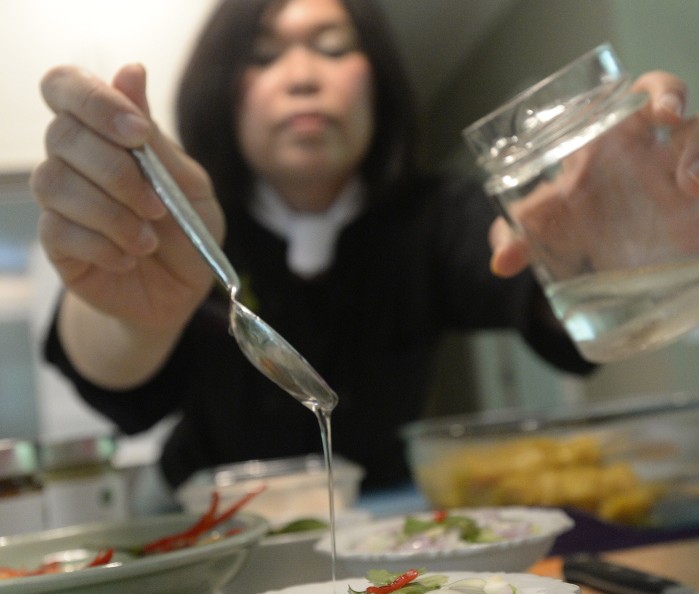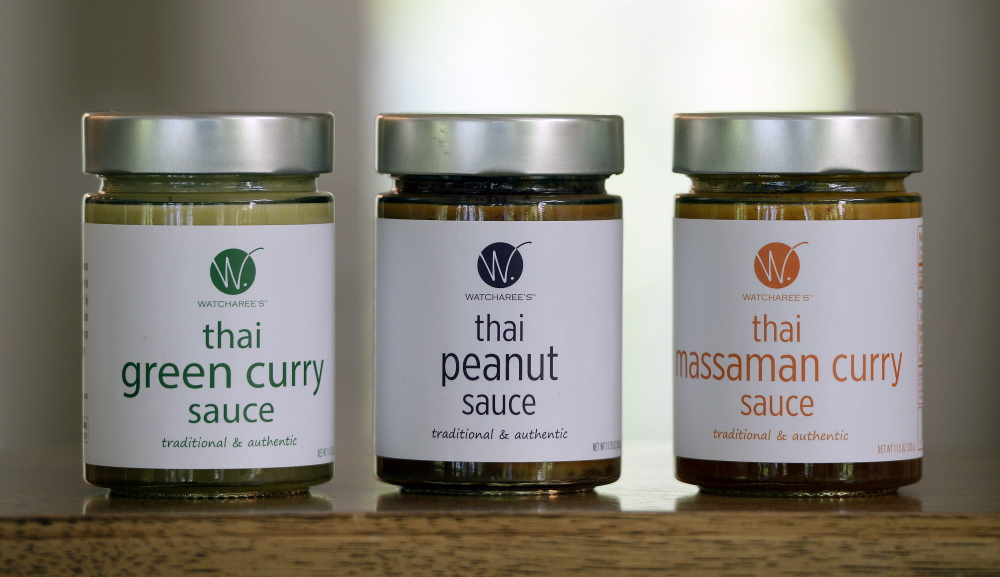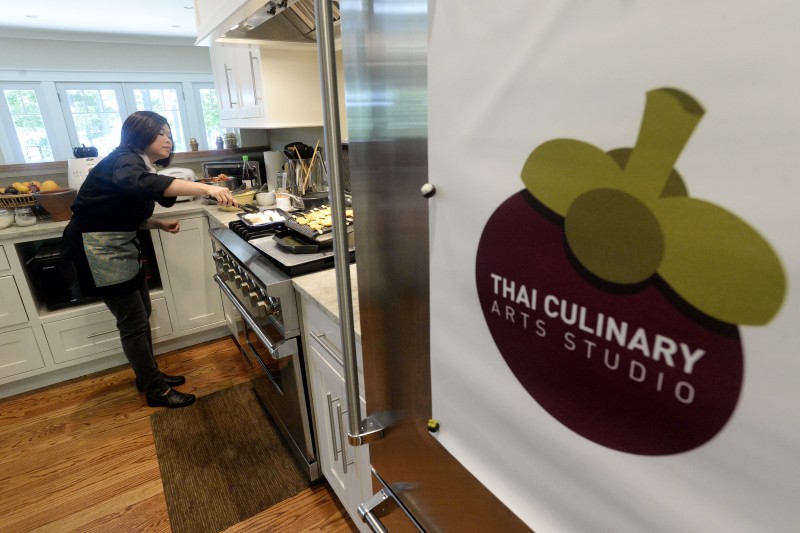YARMOUTH — Watcharee Limanon walked down to the floating dock on Littlejohn Island where Valerie Langmaid and her lobsterman husband store extra lobsters for friends and neighbors who drop by wanting the freshest shellfish possible for their lobster rolls or shore dinners.
Today the Langmaids’ lobsters will be going into Limanon’s green papaya and carrot salad, one of several Thai dishes we’ll be making together in her Cousins Island kitchen on this gloriously sunny summer day.
Langmaid pulls up a lobster trap and opens it so Limanon can pick out four hardshells, fat with meat.
Before we leave, Limanon warns her friend: “I’m coming to get crabs tomorrow.”
Limanon, a native of Bangkok, is an environmental lawyer embarking on a new path in life, one in which she will teach traditional Thai cooking to Mainers. She’s calling her new business the Thai Culinary Arts Studio. In addition to regular cooking classes, Limanon plans to offer group dinner party classes and, eventually, culinary travel to Asia.
For now, the studio is based in her home kitchen that she shares with her husband, who is also an environmental lawyer, and 7-year-old twins. In May, Limanon released the first three products she developed there, a line of Thai culinary sauces inspired by traditional recipes more flavorful than the brands you typically find on grocers’ shelves. Already, Watcharee’s Thai Sauces – green curry, massaman curry and peanut – are in 27 stores in southern and central Maine, including Browne Trading Co., Rosemont Markets, Aurora Provisions, Black Tie Market and Bistro and LeRoux Kitchen. (For a complete list, visit watcharee.com.)
Limanon imports the coconut milk, curry paste, palm sugar, tamarind and other essential ingredients from Thailand. There’s no coconut powder or xanthan gum in her sauces.
Her desire to use only quality ingredients dates back to the time she worked as a waitress in Thai restaurants to help put herself through law school. She recalled peeking into the restaurants’ kitchens and, time and again, finding cooks substituting vinegar for tamarind in their pad thai, “which has a very different flavor.”
Keeping the sauces as authentic as possible means that they cost a little more than other brands, around $9. But to Limanon, who is trying to keep up with the rising price of coconut milk, the cost is worth it.
Back in her home on Potato Point, Limanon put the lobsters on to steam and made us a manao soda with limes, simple syrup and soda water, both refreshing on this warm day and beautiful to look at, with a coral-colored nasturtium and some mint dropped into the glass. Before cooking, we chatted a bit about her background, and it soon became apparent she comes by her talents naturally: Her father was a Supreme Court judge in Thailand, and her mother was “a great cook.”
“When I grew up, at 5 o’clock in the morning on weekends I would hear her pounding curry paste,” Limanon said, sitting in a living room filled with furniture and decor that she had shipped over from Bangkok. “The kitchen was underneath my bedroom. She loved to just share her food, give it away to her neighbors. They all loved it when she’d come with a big pot of curry. And sometimes we’d go to the temple. She would make a pot and we’d give it to the monks.
“I think that’s how I got that – I love to share. I like to make food, and I give it away.”
But when she grew up, Limanon chose law school over culinary school.
In Thailand, a law degree is a bachelor’s degree, so after she graduated and passed the bar, she came to the United States in 1994 to get her master’s degree in international and environmental law at George Washington University.
In Washington, she helped facilitate a memorandum of understanding between Thailand and the U.S. Environmental Protection Agency to improve environmental laws in Thailand. That led to an internship with that agency and then a job with the World Bank and, eventually, with an engineering firm that contracted with the U.S. Agency for International Development.
Her work took her to India, Indonesia, Vietnam, Korea and Japan, and she worked on multiple projects in Thailand. In each place, she visited local markets. The more she began to appreciate other cuisines, the more it made her think about Thai food.
“I wanted to learn the traditional way of cooking, so I went to the source,” Limanon said.
She enrolled in the Oriental Professional Thai Chef Programme at the Mandarin Oriental Hotel in Bangkok, one of the top cooking schools in Thailand, led by the hotel’s executive chef Vichit Mukura. (The Mandarin Oriental Hotel, on the banks of the Chao Phraya River, is also known for playing host to famous literary figures such as Somerset Maugham and Joseph Conrad.)
Limanon hopes to make cooking classes at the hotel a part of her culinary tours, to launch within a couple of years.
Limanon also took a course at Le Cordon Bleu Dusit Culinary School in Bangkok, which attracts students from all over Asia.
She returned to the United States with her husband in 2012 and began planning her transition from law to food. As she developed each version of Watcharee’s Thai Sauces, she passed them out to neighbors and friends on the island to get their opinions, including “the bus driver who has no clue about Thai food. He tasted it and loves it.”
LOBSTERS DONE STEAMING, Limanon handed me a shredding tool and told me to finish shredding the papaya and carrots while she took care of breaking down the shellfish.
Green papaya and carrot salad, Limanon said, is street food in Thailand, where it’s more often eaten with chicken. “People would pack that with sticky rice and go out in the field,” Limanon said.
If you’re having a party, she suggests serving it as an appetizer in a shot glass, or in a martini glass with a piece of lobster hanging over the edge.
After I finished shredding, I set the carrots and papaya aside and mashed some garlic and a couple of red chilis in a mortar and pestle. Then I added lime, fish sauce and palm sugar. The palm sugar, darker than regular sugar and with a more caramel-like taste, helps balance the sourness of the lime and stringent taste of the fish sauce.
“You can check it at the end and then add some more,” Limanon said. “That’s the beauty of Thai cooking. It’s not baking, where you have to be exact. You can adjust the flavors to what you like.”
Next I added the shredded papaya and carrots, followed by cherry tomatoes and ground roasted peanuts. Once the salad was plated, the lobster tails, split down the middle into two pieces, were laid on top. Limanon suggests saving some of the previously made sauce to pour over the lobster just before serving.
She’ll save the lobster shells to use in some tom yum goong, the popular Thai sweet-and-sour soup. “It’s delicious with lobster tail stock,” she said.
Our other dishes were made with two of Limanon’s Thai sauces and illustrated just how easy it is to put together a meal when the sauce is already made for you. Limanon had marinated chicken strips overnight for Thai Chicken Satay, using yellow curry powder, turmeric, sugar, light soy sauce and oil. All we had to do was grill the chicken on an indoor grill, then serve it with Watcharee’s Thai Peanut Sauce. (Limanon said she also likes using the peanut sauce on tofu and quinoa salad.)
To go with the chicken, Limanon prepared a small cucumber-and-shallot salad, which she topped with a dressing of sugar, vinegar and salt.
For our third dish, we simply heated a jar of Watcharee’s Green Curry Sauce in a pan, along with some added basil, diced carrots and shredded kaffir lime leaves, which can be found in Asian grocery stores. We seared a few scallops and put them in a beautiful serving dish, poured the sauce over them and ate them with steamed rice.
Easy peasy.
Limanon also likes serving the green curry sauce with chicken or salmon. She cooks a lot of Thai food for her family, she said, as well as Japanese and Korean dishes. She also likes experimenting with fusion. At cooking demonstrations, she hands out recipes for turkey pot pie made with her massaman curry sauce.
Limanon said she hopes to start hands-on cooking classes in her own kitchen this fall. She’ll post details and a class schedule on her website, thaiculinaryarts.com.
“I want people, when they walk into this studio, to be excited about learning,” she said. “And I hope when they leave the studio they feel really happy, satisfied, and they can go home and replicate the recipes.
“And they can share with their friends.”
Send questions/comments to the editors.





